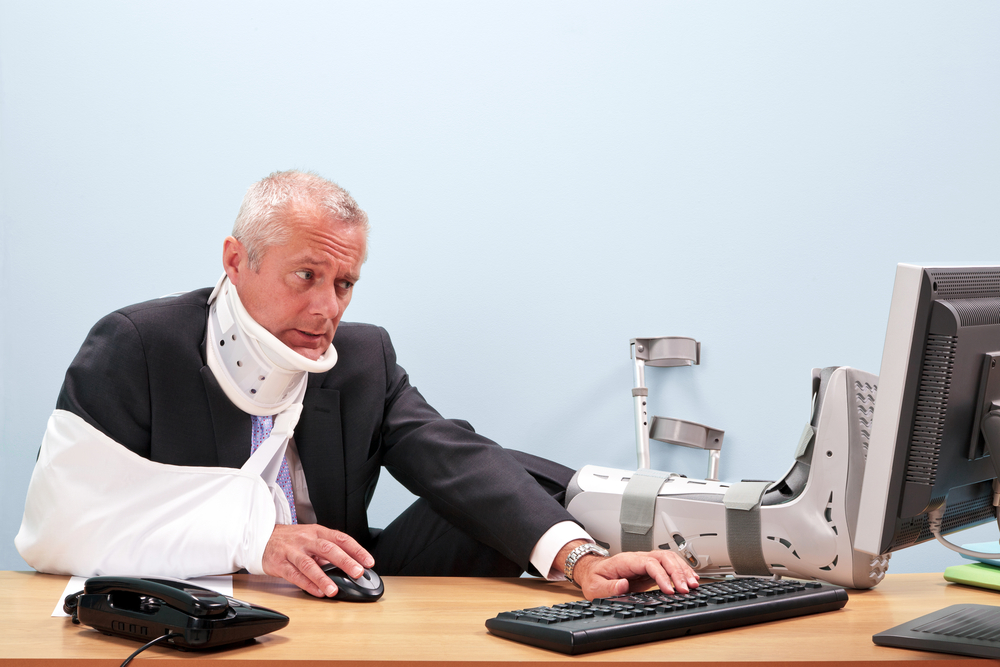A slip-and-fall case is exactly what it sounds like, — a lawsuit occasioned by a fall. It could also be called a trip-and-fall case since, while many falls do take place on wet or icy pavements, a large portion of incidents occur when a person trips on a staircase, catches their toe in a crack in the sidewalk or encounters a pothole on an asphalt path. If the fall takes place on property a victim owns, in most instances, they are on their own. However, if they fall on someone else’s property, they may have grounds for a slip-and-fall lawsuit.

Premises Liability Claims
We say may have grounds because the hazard that occasioned the fall must be a result of the property owner’s failure to keep the premises in good order. Misfortunes like these fall under the heading Premises Liability Claims. And although the above-cited causes spring to mind, when we think of places we might slip and fall, incidents can and do occur anywhere.
- Indoors: where carpeting is loose; lighting is dim due to burned out bulbs; a floor is wet the roof is leaking or a spill was not wiped up; a stairway step is wobbly, or a railing is missing; or when an escalator malfunctions.
- Outdoors: where snow has not been shoveled in a reasonable time; ice has been left untreated; or deep puddles obscure where a curb begins.
The irony of such claims is that although they appear to be open and shut cases, the onus of proof falls to the injured party. In other words, should you slip and fall due to a property owner’s failure to keep the premises free of hazards, it is up to you to prove that this was a case of negligence and not because you weren’t paying attention to your surroundings or failing to avoid a dangerous situation.
Proving Fault in Slip-and-Fall Lawsuits
Proving who is at fault, you the injured victim or the property owner, is a two-edged sword. On the one hand, you have to prove that there was no carelessness on your part. On the other hand, you have to make the point that had the dangerous condition not existed you never would have fallen. And furthermore, that the owner either caused it, or knew about it (or should have), and yet failed to remedy it.
At this point, a third party charged with judging who is at fault may very well view it as a case of he said, she said. So you have to gather and furnish tangible proof either in signed witness statements or police reports. It also helps to take photographs as soon as possible after the incident. And if it occurred in your apartment complex or a store you often frequent, talk to people you are familiar with to see if anything similar happened or nearly happened to them. And if they are willing, ask them to back you up with a written statement for a deposition, or even better to appear at any hearing that may occur in the future.
The Importance of Would Have, Should Have in Determining Negligence
No matter where a slip-and-fall accident takes place, in a store, apartment building, or at a place of employment, the first order of business in is to determine whether or not negligence was involved. In other words, did the property owner or his agent fail to act reasonably in recognizing a dangerous condition; have ample opportunity to repair or remove it, yet fail to act.
The key word here is reasonably. In other words
Would a reasonable person have recognized a condition was a trip-and-fall waiting to happen; And should he have remedied it by the time of the accident?
This type of reasoning holds true whether the supposedly reasonable person is a landlord, store proprietor or restaurant owner However, when it comes to places of employment, it becomes a bit more difficult since different industries present different hazards, and each has proscribed ways of dealing with them in order to get work done safely. These may involve warning signs, guardrails, safety harnesses, safety nets, helmets, harnesses, and the like. In cases like this it’s up to you, to determine whether the company acted in the right way or were they lax or lazy? If you feel powerless in such a case, you have every right to feel this way. This is a chore for a reputable law firm with years of experience in trip-and-fall cases.
Reasons to Engage Legal Counsel
You can be sure that landlords, store owners, and industry have powerful attorneys at their beck and call, ready to spring into action for just such cases. Not only that but it’s a safe bet that the first action they take will be to insinuate that you the victim were responsible for your fall because you were preoccupied or in some other way displaying carelessness as you reached the area. Following that, or perhaps in conjunction, they may claim that they never knew the hazard existed, nor did anyone alert them of its existence prior to your accident. Or if they were notified, it was just before you fell and left them no time to act on it.
Another thing legal counsel can help you with is determining how much compensation you are entitled to. In order to come up with a dollar and cents amount they will take into consideration
- The severity of the injury
- Medical expenses
- Lost wages
- Where the accident occurred – on private or government owned premises
- Available insurance and assets
- Any evidence you provide.
If you feel you can tackle such an endeavor, it’s worth a try. But if you want to win your slip-and-fall case, we invite you to call us and schedule a free consultation.